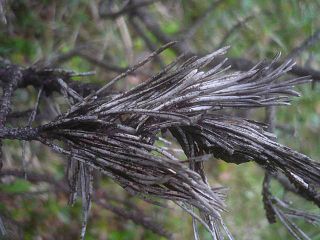Related Research Articles
The Melanommataceae are a family of fungi in the order Pleosporales. Taxa are widespread in temperate and subtropical regions, and are saprobic on wood and bark.
The Roussoellaceae are a family of fungi in the order Pleosporales. As accepted by Wijayawardene et al. 2020;
The Phaeosphaeriaceae are a family of fungi in the order Pleosporales. Species in the family have a cosmopolitan distribution, and are generally nectrotrophic or saprobic on a wide range of plants.
The Didymosphaeriaceae are a family of fungi in the order Pleosporales. The family was erected by Anders Munk in 1953.

Herpotrichia is a genus of fungi in the family Melanommataceae.
Paraphaeosphaeria is a genus of fungi in the Didymosphaeriaceae family. The genus has 23 species found in Europe and North America. Anamorph forms are found in the genus Paraconiothyrium. The genus was circumscribed by O.E. Eriksson in 1967.
Kalmusia is a genus of fungi in the family Didymosphaeriaceae. The genus was formerly placed in family Montagnulaceae,, before that was dissolved. The widespread, genus was estimated to contain about 12 species in 2008, which has increased to 29 species in 2023.
Nodulosphaeria is a genus of fungi in the family Phaeosphaeriaceae.

Phaeosphaeria is a genus of fungi in the family Phaeosphaeriaceae. It has about 95 species. The genus was circumscribed by Japanese mycologist Ichiro Miyake in 1909, with Phaeosphaeria oryzae assigned as the type species.
Splanchnonema is a genus of fungi in the family Pleomassariaceae. The genus was circumscribed in 1829 by August Carl Joseph Corda. One of the species, Splanchnonema lichenisatum, is a lichen.
Broomella is a genus of fungi in the family Sporocadaceae.
The Hyponectriaceae are a family of fungi, that was formerly in the order Xylariales. It was placed in the Amphisphaeriales order in 2020.

Leptosphaerulina is a genus of fungi in the class Dothideomycetes. The relationship of this taxon to other taxa within the class was unknown in 2007 until it was placed within the Didymellaceae family in the Pleosporales order. The genus was first described by Australian plant pathologist Daniel McAlpine in 1902.
Salsuginea is a genus of fungi in the class Dothideomycetes. The relationship of this taxon to other taxa within the class was unknown in 2007. Until Kevin D. Hyde & Tibpromma, 2013 introduced family Salsugineaceae within the order of Pleosporales.
Comoclathris is a genus of fungi in the family Diademaceae.
Didymosphaeria is a genus of fungi in the family Didymosphaeriaceae.
Keissleriella is a genus of fungi, that was originally placed in the Massarinaceae family, before being placed in the Lentitheciaceae family.

Massarina is a genus of fungi in the Massarinaceae family. Anamorph forms of species in Massarina include Acrocalymma, Ceratophoma, and Tetraploa. Massarina was circumscribed by Pier Andrea Saccardo in 1883. The widespread genus contains about 100 species.
Seimatosporium is a fungus genus within the family Sporocadaceae.
Microsphaeropsis is a genus of fungi belonging to the family Didymosphaeriaceae.
References
- ↑ Berlese AN. (1896). Icones Fungorum. Pyrenomycetes. p. 68.
- ↑ Kirk PM, Cannon PF, Minter DW, Stalpers JA (2008). Dictionary of the Fungi (10th ed.). Wallingford, UK: CABI. p. 438. ISBN 978-0-85199-826-8.
- ↑ Lumbsch TH, Huhndorf SM (December 2007). "Outline of Ascomycota – 2007". Myconet. Chicago, USA: The Field Museum, Department of Botany. 13: 1–58.
- ↑ Wijayawardene, Nalin; Hyde, Kevin; Al-Ani, Laith Khalil Tawfeeq; Somayeh, Dolatabadi; Stadler, Marc; Haelewaters, Danny; et al. (2020). "Outline of Fungi and fungus-like taxa". Mycosphere. 11: 1060–1456. doi: 10.5943/mycosphere/11/1/8 .
- 1 2 3 "Species Fungorum - Search Page - Montagnula". www.speciesfungorum.org. Retrieved 4 August 2023.
- ↑ Burkhardt, Lotte (2022). Eine Enzyklopädie zu eponymischen Pflanzennamen [Encyclopedia of eponymic plant names](pdf) (in German). Berlin: Botanic Garden and Botanical Museum, Freie Universität Berlin. doi:10.3372/epolist2022. ISBN 978-3-946292-41-8 . Retrieved January 27, 2022.